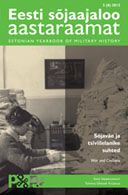Sõja mõju tsiviilelanikkonnale keskaegse Liivimaa konfliktides
Non-military population in war: the case of medieval Livonia
Author(s): Mart LätteSubject(s): History, Military history, 16th Century
Published by: Tallinna Ülikooli Kirjastus
Summary/Abstract: According to the battle-centred doctrines of the war theorist Karl von Clausewitz, historians were for a long time on the opinion that medieval warfare, which did not involve a striking number of battles, was nothing but uncoordinated and pointless pillage. The view began to change in the second half of the 20th century mostly due to the works of Jan Frans Verbruggenand Philippe Contamine.In fact, medieval warfare was very thoroughly-planned and the warof pillage had its own specific purposes. Unlike the times of Clausewitz,when the purpose of warfare was to gain victory by destroying the enemy army in battle, in the Middle Ages, battles were avoided and belligerents tried to force the opponent to surrender in other ways. The destroying of the economic potential and the population of the opponent by pillagingand killing played an important part in the process. Thus, it can be said that warfare was directed against that part of the society nowadays known as the civilian population. (Longer version of this abstract is included in the article, starting from p 30.)
Journal: Eesti Sõjaajaloo Aastaraamat
- Issue Year: 2/2012
- Issue No: 1
- Page Range: 9-31
- Page Count: 23
- Language: Estonian

